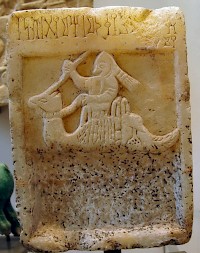Sardes (547 BCE??)
Battle of Sardes (c.547??): decisive battle in the war between the Lydian king Croesus and the Persian conqueror Cyrus the Great, who defeated his opponent and captured his capital.

Sardes was the capital of ancient Lydia, the kingdom of the proverbially rich Croesus. Somewhere between 547 (the year in which he conquered Urartu) and 539 (the year in which he took Babylon), the Persian king Cyrus the Great defeated Croesus on the plains north of Sardes. The battlefield itself has not been identified.
According to the Greek researcher Herodotus of Halicarnassus, the Persian king used a stratagem.note The horses of the Lydians had never seen or smelled dromedaries and were afraid of them, so Cyrus placed these animals in the Persian front line. This picture shows the Arab warrior Mushayqat Hamayat ibn Yusuf on a dromedary; it is a funerary stele from Saba dating back to the second century CE, now in the Louvre, Paris. Similar warriors must have been in Cyrus' army.
After the victory on the plain of Sardes, Cyrus laid siege to the citadel of the city of Sardes, a steep rising rock that was captured after a brief blockade. From now on, the Persians ruled the Lydians and their subjects, which included the Carians and the Yaunâ (the Greeks), notorious pirates and clever salesmen from the west.
King Croesus was executed. The famous story, told by Herodotus, that the Lydian king was saved from the pyre by a rain shower, is contradicted by Bacchylides (Third Ode), who says that Croesus was taken away to the Hyperboreans, i.e., the realm of the dead. Herodotus has rationalized this story, and when he presents Croesus in his story as adviser of Persian kings, it is always in the role of "tragic warner". This is obviously a literary construction.
Time and again, it is stated that the fall of Sardes and the death of Croesus are mentioned in a contemporary source from Babylon, the Chronicle of Nabonidus. If this were correct, the event could be dated in 547 BCE, but it is not certain that this reading of the cuneiform is correct; it is more likely that Cyrus was in that year in Urartu (more...).